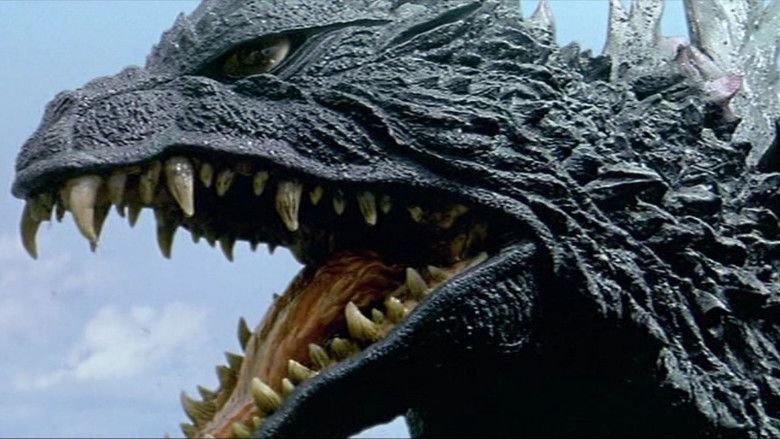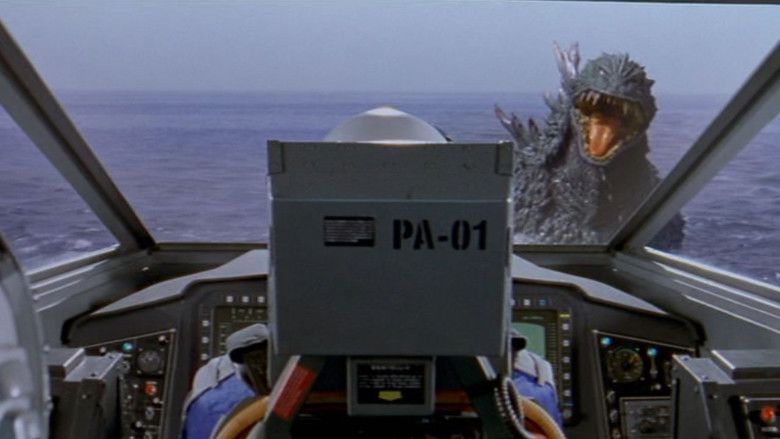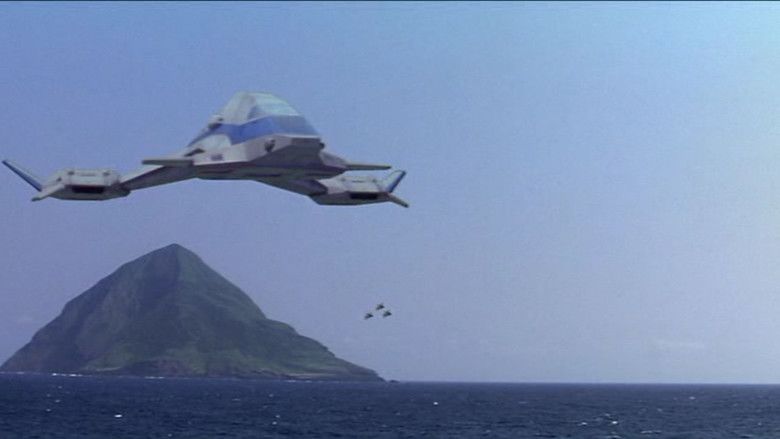Godzilla vs Megaguirus
6.2 /10 1 Votes6.2
Director Masaaki Tezuka Film series Godzilla Country Japan | 6.3/10 IMDb Genre Action, Horror, Sci-Fi Duration Language Japanese | |||||||||||||||||||||||||||||||||
 | ||||||||||||||||||||||||||||||||||
Release date November 3, 2000 (2000-11-03) (Tokyo International Film Festival)December 16, 2000 (2000-12-16) (Japan) Cast (Kiriko Tsujimori), Masat? Ibu (Motohiko Sugiura), Shosuke Tanihara (Hajime Kudo), (Yoshino Yoshizawa), (Takuji Miyagawa), Kôichi Yamadera (Kid's TV Host)Similar movies Ghidrah, the Three-Headed Monster , Mothra vs. Godzilla , Invasion of Astro-Monster , Godzilla: Final Wars , Godzilla , The Return of Godzilla | ||||||||||||||||||||||||||||||||||
Godzilla vs megaguirus 2000 teaser trailer godzilla 2001
Godzilla vs. Megaguirus (ゴジラ × メガギラス G消滅作戦, Gojira tai Megagirasu: Jī Shōmetsu Sakusen, also known as Godzilla X Megaguirus: The G Extermination Strategy) is a 2000 Japanese science fiction tokusatsu kaiju film featuring Godzilla, produced and distributed by Toho. It is the 25th film in the Godzilla franchise, the 24th Godzilla film produced by Toho, and the second film in the Millennium series. The film is directed by Masaaki Tezuka and written by Hiroshi Kashiwabara and Wataru Mimura. The film premiered at the Tokyo International Film Festival on November 3, 2000. While the film uses the Godzilla suit from Godzilla 2000, it is not connected to the previous film.
Contents
- Godzilla vs megaguirus 2000 teaser trailer godzilla 2001
- Plot
- Cast
- Release
- Reception
- Home Media Releases
- References

Plot

The prologue of the film acknowledges the events of the first Godzilla film (using the present Godzilla monster rather than the 1954 monster), while inventing its own timeline, explaining that the capital of Japan was moved from Tokyo to Osaka. The film takes place in an alternate universe with advanced technology, explaining that in 1966, Godzilla attacks the first Japanese nuclear plant in Tokai, Ibaraki Prefecture. After this, the G-Graspers, a section of Japanese Self Defence Force, was dedicated to fight Godzilla. In 1996, clean plasma energy replaced nuclear energy, but this did not deter Godzilla from attacking. Plasma energy is also banned, due to the fact that Godzilla attacked the original plasma energy reactor.

In 2001, an experimental satellite-based weapon that fires miniature black holes, called the Dimension Tide, opens a wormhole through which a prehistoric dragonfly enters the present and deposits a single egg before exiting through the wormhole. A boy finds the egg and takes it with him when he moves to Tokyo. The egg starts oozing a strange liquid, so the boy throws the egg in the sewer. The egg, actually a mass of hundreds of eggs, splits up and starts growing when exposed to water, hatching into large dragonfly larva called Meganulon that come out of the sewer to feed. They flood a portion of the city and molt on the sides of buildings, becoming adult Meganula.

Meanwhile, Godzilla appears in search of a source of nuclear energy, despite the edict shutting down all such attractants after its three previous appearances. While Godzilla is fighting the G-Graspers, who are assisted by rebellious scientist Hajime Kudo, the swarm of Meganula are attracted in turn to Godzilla's energy, and attack it. During the course of the battle, the Dimension Tide is launched, but Godzilla survives the attack. Most of the Meganula are killed by both Godzilla and the Dimension Tide, but a few manage to drain off some of Godzilla's energy and return to the sewer. With the last of their strength, the Meganula inject Godzilla's energy into a huge, sleeping larva that is in a giant, pulsating cocoon. It molts and appears from the water as Megaguirus, the queen of the Meganula.
After destroying part of Tokyo with shock waves generated by her beating wings, Megaguirus heads to the waterfront and faces Godzilla. Being territorial, Megaguirus considers the city to be her hunting ground. As they engage in a lengthy battle, she uses her speed to avoid Godzilla's attacks, but Godzilla eventually uses his speed against her. As she flies toward Godzilla, it lunges forward with its dorsal fins in her path. She flies into the fins, and one of her arms is severed. Megaguirus, having been mutated by Godzilla's energy, generates a blast similar to Godzilla's atomic breath and knocks Godzilla down. Megaguirus speeds forward with the stinger on her long tail lowered, trying to stab Godzilla between the eyes. In a climactic moment, Godzilla catches the stinger in its mouth and crushes it in its jaws. Godzilla finally blasts Megaguirus with atomic breath, causing her to burst into flames and die.
It is revealed that Godzilla was attracted to a secret plasma energy project housed at the Science Institute, in violation of the ban. The G-Graspers continue their mission to destroy Godzilla, but with the Dimension Tide falling out of orbit they are unable to get a lock on it. The vengeful Major Kiriko Tsujimori pilots a ship towards Godzilla, ejecting only at the last second. The Dimension Tide is able to lock on to the craft and fires just before burning up on reentry; Godzilla blasts at the approaching black hole with its atomic fire but vanishes. In a postlude, however, Tsujimori again enlists Kudo to investigate suspicious seismic activity; then in an after-credits scene, Godzilla's roar is heard again. An after-effect of the Dimension Tide machine is temporary wormholes. As Megaguirus came to Earth through one, did Godzilla return to Earth through a wormhole caused by it being sent into the black hole?
Cast
The cast of Godzilla vs. Megaguirus are predominantly new faces to the Godzilla series, but the film began a tradition in the Millennium series of casting veteran genre cast members, especially from the Shōwa era, in older, authoritarian roles: Yuriko Hoshi, who played photographer Junko in Mothra vs. Godzilla and reporter Naoko in Ghidorah, the Three-Headed Monster, appears as Professor Yoshizawa, director of the Dimension Tide project.
Release
Godzilla vs. Megaguirus was released theatrically in Japan on December 16, 2000 where it was distributed by Toho. The film was released directly to television in the United States by Columbia TriStar with an English dub. There are some inconsistencies in the translation of the dub however, including one scene where Hajime tells Kiriko that body building is a waste of time since they'll be making Godzilla disappear "up his own butthole" rather than their artificially created "black hole" as the original version states.
Reception
Godzilla vs. Megaguirus was released on December 16, 2000 to mixed reactions. Ed Godziszewski of Monster Zero said, "While not the best example of filmmaking, Godzilla vs. Megaguirus nonetheless succeeds as an entertaining film." Miles Imhoff of Toho Kingdom said, "Run-of-the-mill, mediocre, and sterile are the three words that best describe Godzilla vs. Megaguirus. It is a movie that attempts to be creative and edgy, but somehow fails, leaving one wanting with futility to really try to enjoy the film."
Stomp Tokyo said "the music is pretty good" but "this movie isn't a step forward in the ways that it really should be." Mike Bogue of American Kaiju said, "Though not the best of the post-Showa Godzilla movies, Godzilla vs. Megaguirus is one of the most entertaining." Ian Jane of DVD Talk said, "While not the best entry in the Godzilla series, Godzilla vs. Megaguirus ... [is] still a really solid entry with some great special effects and a very memorable monster mash finale."
Matt Paprocki of Blog Critics called the film "a true classic in the series," adding: "It's impossible not to be entertained somewhat, whether you're looking for camp value or serious giant monster action. This one has everything that is required of the [kaiju] genre." Andrew Pragasam of The Spinning Image called the film a "flawed, but entertaining comic book extravaganza" that "only partially delivers as a slam-bang monster epic" and suffers from "a lack of likeable characters."
Home Media Releases
Sony - Blu-ray (Toho Godzilla Collection)
Columbia/Tristar Home Entertainment
References
Godzilla vs. Megaguirus WikipediaGodzilla vs. Megaguirus IMDbGodzilla vs Megaguirus themoviedb.org
